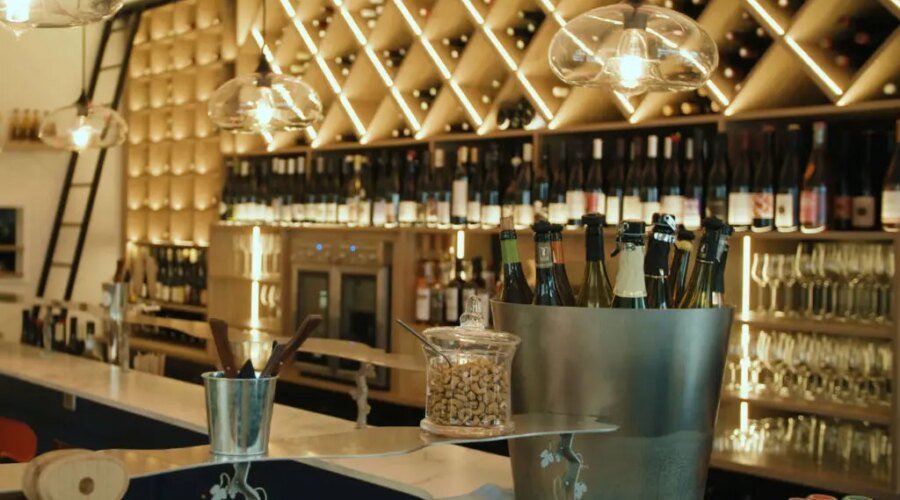This Castle-Studded Wine Region Is Straight Out of a Fairytale
The Loire Valley is an undisputed wine region champion, hailed for its cool-climate, lower abv styles. It also happens to be a lovely place to visit, especially as a weekend trip from Paris. The region, which encompasses the valley on either side of the middle part of the Loire River, runs through the central part of France and is easily accessible by train.
Beyond wine, it’s famous for its spectacular chateaus, from massive and grandiose to small and intimate, with dozens of them open to the public. It’s also home to tons of charming villages, so don’t be afraid to get lost and wander a bit.
It’s a rather large region (about 310 square miles), so we’ve chosen to focus on the central part of it, which includes the historic towns of Amboise, Blois, and Tours. Take the train from Paris to Tours or Blois-Chambord, and from there you can rent a car or bicycle to get around.
So, whether you’re seeking a countryside escape from the City of Lights or just want to drink all the wines and visit Disney-like castles, read on for our 36-hour itinerary that spans the central Loire Valley and its various activities—including some excellent wineries.
// Create the element
var script_69552cf723b2f = document.createElement(“script”);
script_69552cf723b2f.innerHTML = `
window.googletag = window.googletag || {cmd: []};
googletag.cmd.push(function() {
var adType = “leaderboard”;
var mapping;
var lbmapping = googletag.sizeMapping()
.addSize([1024, 0], [[970, 250], [970, 90], [1, 1], [728, 90]])
.addSize([728, 0], [[728, 90], [1, 1]])
.addSize([320, 0], [[1, 1], [300, 50], [300, 100], [320, 50], [320, 100]])
.addSize([0, 0], [[1, 1], [320, 50]])
.build();; // Size mapping for leaderboard ads
var medrecmapping = googletag.sizeMapping()
.addSize([1024, 0], [[300, 600],[300, 250]])
.addSize([728, 0], [300, 250])
.addSize([320, 0], [[1, 1],[300, 250]])
.addSize([0, 0], [[1, 1], [300, 250]])
.build(); // Size mapping for med rectengle ads
if(‘/39808611/article_page/article_leaderboard_1’ == ‘/39808611/article_page/article_leaderboard_1’
|| ‘/39808611/article_page/article_leaderboard_1’ == ‘/39808611/article_page/article_leaderboard_2’
|| ‘/39808611/article_page/article_leaderboard_1’ == ‘/39808611/article_page/article_leaderboard_3’) {
mapping = googletag.sizeMapping()
.addSize([1920, 0], [[728, 90]]) // >= 1920px
.addSize([1440, 0], [[728, 90]]) // 1440px-1919px
.addSize([730, 0], [[300, 250]]) // 730px-1439px
.addSize([0, 0], [[320, 100], [320, 50], [300, 100], [300, 50], [300, 250]]) // Up to 729px
.build();
} else {
mapping = adType == ‘leaderboard’ ? lbmapping : medrecmapping;
}
googletag.defineSlot(‘/39808611/article_page/article_leaderboard_1’, [],
‘div-gpt-ad-69552cf723b2f’).addService(googletag.pubads()).defineSizeMapping(mapping);
googletag.pubads().enableSingleRequest();
googletag.pubads().collapseEmptyDivs();
googletag.display(‘div-gpt-ad-69552cf723b2f’);
});
`;
// Append the script to the body
document.body.appendChild(script_69552cf723b2f);
Friday
3 pm Have a Sip
If you arrive by train into Tours, go for your first sips of wine and a bite at TuTu, a chic wine bar with tapas-style snacks and a lengthy wine list, with plenty of Loire Valley by-the-glass options including 2018 Famille Gendrier Domaine des Huards and 2019 Luc Tabordet. It’s right near Halles de Tours market, where you can also pick up a few provisions if needed.

4 pm Get the City Off You
After escaping the city, immerse yourself in nature. Check in to Loire Valley Lodges, a unique hotel set in a forest near Esvres, where each of the 18 accommodations is a cabin set on stilts, giving major treehouse vibes. Drop your bags and walk or cycle along the paths snaking through the woods on the property, spotting carefully placed sculptures as you go.
5 pm Bask in Small Town Charm
The tiny town of Esvres is a 30-minutes bike ride from the hotel and is worth a wander to experience a Loire Valley country village.
“There are some good food shops, notably the local butcher, who supplies our charcuterie and, in particular, his delicious rillettes,” shares Anne Caroline Frey, owner of Loire Valley Lodges. “The church in the center of the village is very pretty and the square is pleasant.”

7 pm Dine In
If you’re feeling lazy and cozy, there’s no need to leave the hotel. Its excellent on-site restaurant Ardent (open Thursday to Monday) offers a multi-course pre-fixe menu featuring local and seasonal ingredients, like heritage pork, mackerel, green beans, and black truffle, sometimes foraged by the chef himself. The chalet-style restaurant’s décor is ultra-cozy (think exposed wooden beams, deer heads on the walls, and hand-forged pottery). In winter, the hotel’s outdoor restaurant Asperatus turns into a raclette bar on weekends (in summer it’s an open-fire eatery in the garden). The lengthy wine list has plenty of Loire Valley glasses and bottles, such as 2021 Bodet-Herold Crémant de Loire Les Greffiers and 2020 Domaine Thibaud Boudignon Clos de la Hutte, as well as wines from all around France.
// Create the element
var script_69552cf726c85 = document.createElement(“script”);
script_69552cf726c85.innerHTML = `
window.googletag = window.googletag || {cmd: []};
googletag.cmd.push(function() {
var adType = “leaderboard”;
var mapping;
var lbmapping = googletag.sizeMapping()
.addSize([1024, 0], [[970, 250], [970, 90], [1, 1], [728, 90]])
.addSize([728, 0], [[728, 90], [1, 1]])
.addSize([320, 0], [[1, 1], [300, 50], [300, 100], [320, 50], [320, 100]])
.addSize([0, 0], [[1, 1], [320, 50]])
.build();; // Size mapping for leaderboard ads
var medrecmapping = googletag.sizeMapping()
.addSize([1024, 0], [[300, 600],[300, 250]])
.addSize([728, 0], [300, 250])
.addSize([320, 0], [[1, 1],[300, 250]])
.addSize([0, 0], [[1, 1], [300, 250]])
.build(); // Size mapping for med rectengle ads
if(‘/39808611/article_page/article_leaderboard_2’ == ‘/39808611/article_page/article_leaderboard_1’
|| ‘/39808611/article_page/article_leaderboard_2’ == ‘/39808611/article_page/article_leaderboard_2’
|| ‘/39808611/article_page/article_leaderboard_2’ == ‘/39808611/article_page/article_leaderboard_3’) {
mapping = googletag.sizeMapping()
.addSize([1920, 0], [[728, 90]]) // >= 1920px
.addSize([1440, 0], [[728, 90]]) // 1440px-1919px
.addSize([730, 0], [[300, 250]]) // 730px-1439px
.addSize([0, 0], [[320, 100], [320, 50], [300, 100], [300, 50], [300, 250]]) // Up to 729px
.build();
} else {
mapping = adType == ‘leaderboard’ ? lbmapping : medrecmapping;
}
googletag.defineSlot(‘/39808611/article_page/article_leaderboard_2’, [],
‘div-gpt-ad-69552cf726c85’).addService(googletag.pubads()).defineSizeMapping(mapping);
googletag.pubads().enableSingleRequest();
googletag.pubads().collapseEmptyDivs();
googletag.display(‘div-gpt-ad-69552cf726c85’);
});
`;
// Append the script to the body
document.body.appendChild(script_69552cf726c85);
Saturday
8:30 am Breakfast on the Go
Just a short drive from the hotel, Aux Delices d’Azay is a charming village bakery offering fresh breads, croissants, and other pastries. And if they happen to be closed, there’s a baguette vending machine outside (really).

9 am Explore Da Vinci’s Home
Did you know Leonardo da Vinci spent the last few years of his life in the Loire Valley? His home, Clos Lucé, is now a park and museum open to the public. Stroll the Renaissance-style chateau dating back to 1471 and see the famous artist and inventor’s bedroom, kitchen, and studio. Find replicas of 44 of his inventions based on his blueprints in the chateau and spread out among the surrounding gardens. As you leave, drive by the imposing Royal Palace of Amboise, a favorite of French kings, from Louis XI to Francis I, that towers above the town.

11 am Stroll Amboise and Taste Some Wine
While you’re there, take time to explore the charming town of Amboise, a favorite of Frey. She suggests walking along the banks of the Loire, and be sure to see Michel Audiard’s sculpture tribute to Algerian national hero Emir Abdelkade.
Next, head to Cave SD, a wine cellar by former sommelier Sébastien Durance, for a tasting. “I particularly love this place for its warm and authentic atmosphere, much like Sébastien himself, who passionately shares his discoveries,” says Michelin-starred chef Christophe Hay, of Christophe Hay restaurant in nearby Blois. “His selection highlights Loire Valley wines, featuring iconic appellations as well as a few hidden gems from other French regions.”
Marnie de Vanssay, owner of luxury onsite travel agency Countess Connections, recommends scheduling a vineyard tour and tasting at the picturesque Chateau de Montdomaine, known for its Chenin Blanc, just above Amboise.

1 pm Lunch with Stars
Dine at the two-Michelin-starred Chrisophe Hay, located inside the Relais & Chateaux hotel Fleur de Loire, perched on the Loire River in the charming old town of Blois, a 30-minute drive from Amboise. Enjoy the river views as you indulge in the Loire Valley-inspired lunch menu—choose from four, five, or seven courses and be sure to flip through the gorgeously illustrated cocktail menu. Watch the chefs in the open kitchen, enjoy the elaborate tableside bread service, sip excellent wine pairings, and splurge on caviar from nearby Sologne.

3 pm Stroll Blois
The town of Blois is exceedingly charming and picturesque. Like many Loire Valley towns, it’s bordered by the river, which you can stroll along, and its cobblestone streets are lined with timber-framed houses and pretty squares. Don’t miss the chateau, the cathedral, and the dramatic 1860 Denis Papin staircase, which changes its mural each year. The top offers great views of the city, too.

3:30 pm See a Fairytale Castle
Ever wondered what the inspiration was for the castle in Disney’s Beauty and the Beast? Well now’s your chance to see the French Renaissance masterpiece in person: Chateau de Chambord, one of the Loire Valley’s most beautiful chateaus. Explore the castle’s many rooms, the famous helicoidal staircase, designed by Leonardo da Vinci, the rooftops with over 400 chimneys, and the vast gardens. There’s even an on-site vineyard and winery.

7:30 pm Dinner in Tours
Make your way back to Tours for dinner. Chef Hay suggests La Maison des Halles, the restaurant of chef Henri Leclerc. “It’s a unique place that perfectly captures the convivial spirit of Touraine gastronomy, and the ideal spot to enjoy the emblematic Beuchelle tourangelle, a traditional dish beautifully and thoughtfully revisited,” says Hay, of the veal sweetbreads and kidneys in a mushroom cream sauce. “The well-curated wine list enhances the experience with the perfect bottle to share.”
Sunday

9 am Breakfast at the Market
Frey recommends the market in Amboise, which is every Friday and Sunday on the Place du Marché. Look for local cheese, fresh bread, and other tasty treats. Eat your bounty as you walk along the riverbank.

10 am Sparkling Wine Immersion
Behind Champagne, the Loire Valley churns out some of the best sparkling wines in France. Vouvray is known for its still and sparkling wines made from Chenin Blanc—called Pineau de la Loire here. Frey and de Vanssay suggest Domaine Huet for a Vouvray vineyard and winery visit, and then Frey recommends Domaine de la Taille aux Loups for Montlouis sparklers (a bit drier and more mineral-forward than Vouvray), another pride of the region that’s just down the road about 15 minutes’ drive, on the other side of the river.

12 pm Two Lesser Visited Chateaus
Set on a rural stretch of road with hundreds of acres of parkland, Chateau de Beauregard quietly houses the largest portrait collection (327 of them) of Europe, depicting portraits of royalty who lived between 1328 and 1643, including French kings, queens, ministers, marshals, and diplomats. A former hunting lodge of François I, the chateau was home to the ministers of the kings of the 16th and 17th centuries. It has been owned by the same family since 1926 (who still lives there). But the Galerie des Illustres, housing the portraits and the nearly 100 acres of landscaped park, are open to the public daily April to November.
Owner of Chateau de Beauregard Guy de Pavillon recommends another small chateau, just down the road in Cheverny—near the more popular Chateau de Cheverny. Instead, he suggests Troussay Castle, “A beautiful manor house rebuilt by a collector using decorative elements from chateaux and manor houses in the Blois region that disappeared during the 19th century.”

1:30 pm Last Lunch
For a final taste before catching the train back to Paris, Pavillon suggests a classic French lunch of foie gras, terrines, and venison nearby at Les Trois Marchands, along the charming village square in Cour-Cheverny.
Or for something more modern, he recommends the Michelin-starred Granica, owned by husband-and-wife team Alice and Alexis Letellier. Alexis, the chef, churns out a daily-changing menu of local products with flavorful sauces and beautiful presentations. Alice is in charge of the impressive wine list, which features some of the best bottles the Loire Valley has to offer.
More Travel Coverage
- The ten dreamiest wineries to visit in Provence.
- Bakeries, beaches, and a bit of rosé: a weekend guide to Saint-Tropez.
- Drink like royalty at these European castle wineries.
- These jet-setting fishing and drinking experiences will have you hooked.
- And these international wine and surf destinations are off the hook.

In the Shop
For Wine On-the-Go
This versatile messenger-style wine bag comes with removable bottle liners, a corkscrew and an aerator.
The post This Castle-Studded Wine Region Is Straight Out of a Fairytale appeared first on Wine Enthusiast.


